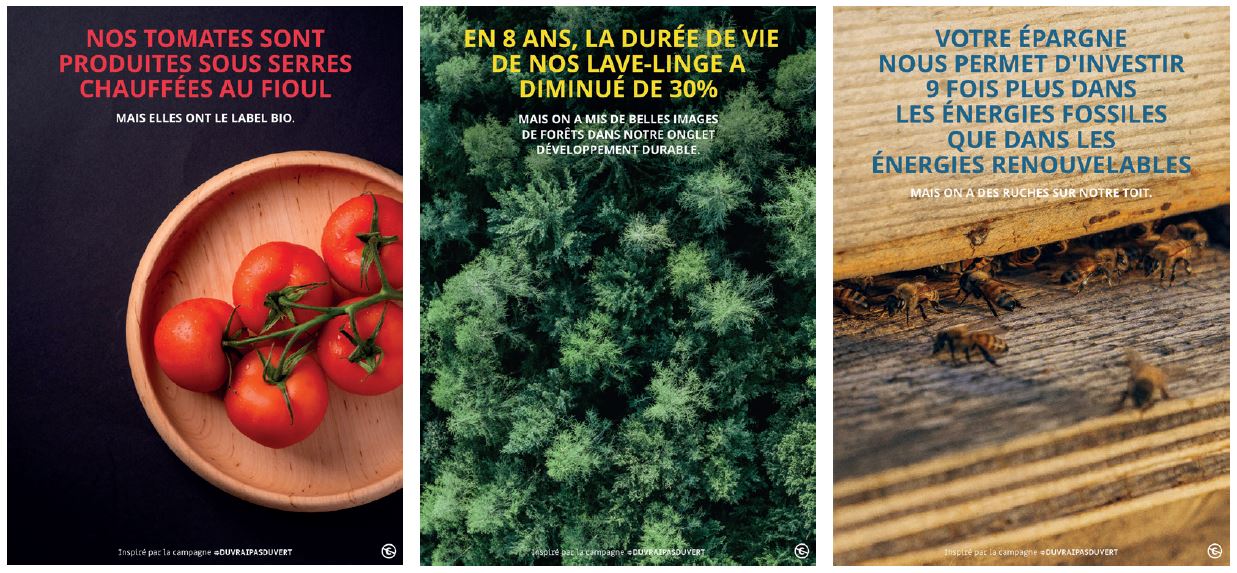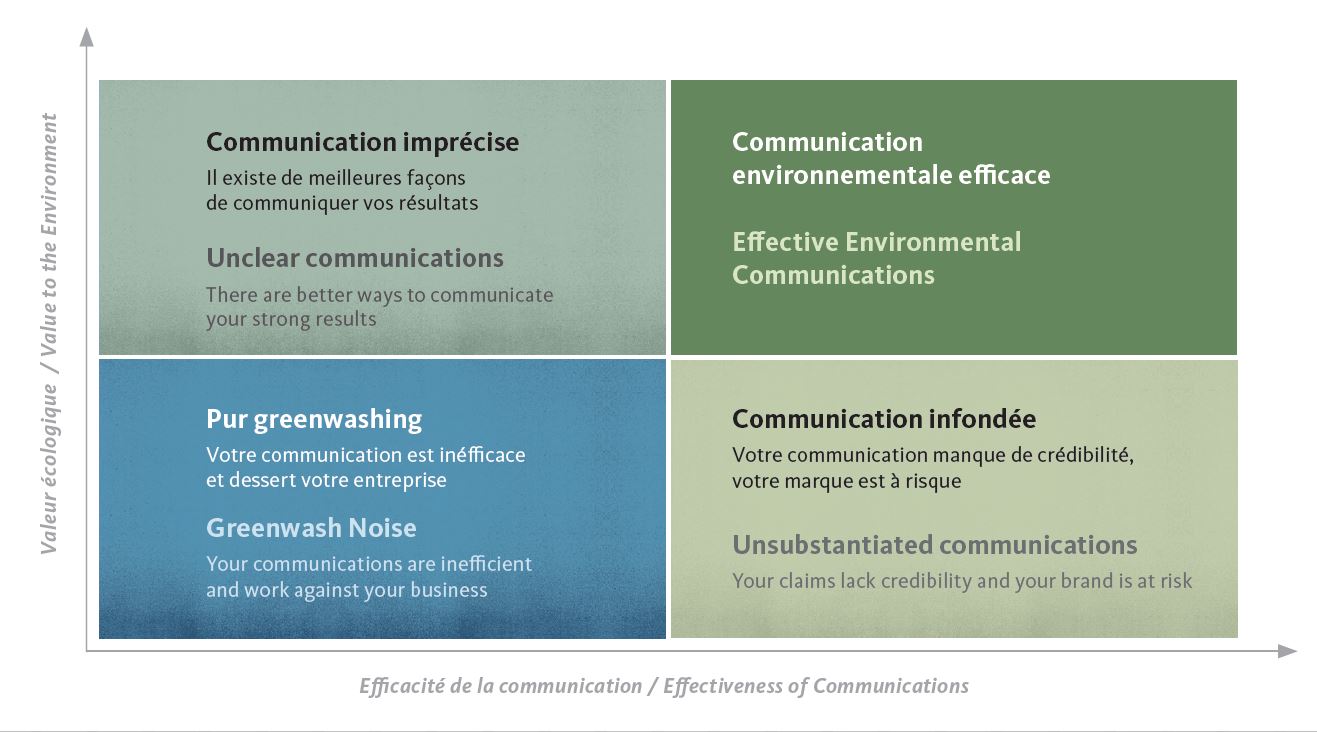Unclear Communication
This category includes companies that are making substantial efforts in terms of environmental performance but have inaccurate communication. They may be making sweeping generalisations or over-promising, or misuse unfamiliar scientific or ecological language. The product may also be presented as totally green when only one of its components is green. These organisations have real potential to move into the "Effective Environmental Communication" quadrant by focusing their messages accurately on positive impacts while supporting these claims with key data.
Tips: Be specific about the reach of your efforts, don't generalise the benefits. Communication on the company's commitments should be specific and present actions whose effects are evaluated. Limit yourself to verified and verifiable positive results. Focus on humility with a clear and controlled message.
Unsubstantiated communication
Lack of evidence is the most common form of marketing drift followed closely by willful imprecision. This most often involves an environmental claim that is not supported by reliable information.Unclearness feeds greenwashing. The use of unclear slogans or slogans such as 'X% recycled waste', 'Y% reduction in CO2 emissions', which are not verifiable, is a sign. These data are then used as a promise but are not validated by any third-party organisation, nor even based on reliable analyses. It is therefore impossible for the consumer to verify the information. As an example, remember that an "all-natural" cleaning product may still contain harmful ingredients that are naturally found in the environment, such as mercury or arsenic. At first glance, words do not commit anything, but misleading rhetoric can only backfire on an organisation. Over time, these companies will move towards the "Pure Greenwashing" quadrant.
Tip: Avoid rhetorical and announcement effects. Above all, focus on sincerity and authenticity. Remember that "do it" must always precede "let it be known". Hollow slogans such as "good for the planet" are to be avoided as they now inspire mistrust. Specify on what your argument is based: on the product, its manufacturing process, its packaging? Concrete evidence is always more credible, and that is precisely what informed consumers are looking for today. Be honest about the strengths of your products. If these strengths can't be verified, undertake a precise analysis. Products without any impacts don't exist, and consumers are willing to accept this, provided there are no miscalculated promises.
Greenwashing Noise
Between ecological opportunism and real lying, the line is subtle. This category relates to companies that voluntarily use marketing to give themselves an environmental image without the slightest foundation. This is a real attempt to manipulate symbolic graphic or sound elements that evoke nature or an ecological image in a more or less subliminal way. False labels are part of it. A puppet "eco-label" can make people believe that it is a real certification when it is only a "home-made" initiative developed without any method of attribution or independent control. Much work remains to be done to move these companies into the upper right quadrant.
Tips: Evaluate the company's impacts throughout its value chain, this will enable you to develop and implement an environmental strategy. Determine concrete and available evidence based on a complete reference framework, precise vocabulary, clear information and an unambiguous logo. Adhere to a recognised and appropriate official label (which will always carry much more weight than a vague self-declaration). Finally, certify that your environmental approach is real, transversal to the company, budgeted and integrated into the company's internal policy.
Effective Environnemental Communication
Effective environnemental communication is the ultimate goal. Companies in this category improve the environmental performance of their products and align this policy to their different functions or along the value chain. They are able to transparently communicate their efforts (both progress and challenges) to consumers and stakeholders alike. This commitment requires an in-depth questioning of its corporate culture.
Unclear Communication
This category includes companies that are making substantial efforts in terms of environmental performance but have inaccurate communication. They may be making sweeping generalisations or over-promising, or misuse unfamiliar scientific or ecological language. The product may also be presented as totally green when only one of its components is green. These organisations have real potential to move into the "Effective Environmental Communication" quadrant by focusing their messages accurately on positive impacts while supporting these claims with key data.
Tips: Be specific about the reach of your efforts, don't generalise the benefits. Communication on the company's commitments should be specific and present actions whose effects are evaluated. Limit yourself to verified and verifiable positive results. Focus on humility with a clear and controlled message.
Unsubstantiated communication
Lack of evidence is the most common form of marketing drift followed closely by willful imprecision. This most often involves an environmental claim that is not supported by reliable information.Unclearness feeds greenwashing. The use of unclear slogans or slogans such as 'X% recycled waste', 'Y% reduction in CO2 emissions', which are not verifiable, is a sign. These data are then used as a promise but are not validated by any third-party organisation, nor even based on reliable analyses. It is therefore impossible for the consumer to verify the information. As an example, remember that an "all-natural" cleaning product may still contain harmful ingredients that are naturally found in the environment, such as mercury or arsenic. At first glance, words do not commit anything, but misleading rhetoric can only backfire on an organisation. Over time, these companies will move towards the "Pure Greenwashing" quadrant.
Tip: Avoid rhetorical and announcement effects. Above all, focus on sincerity and authenticity. Remember that "do it" must always precede "let it be known". Hollow slogans such as "good for the planet" are to be avoided as they now inspire mistrust. Specify on what your argument is based: on the product, its manufacturing process, its packaging? Concrete evidence is always more credible, and that is precisely what informed consumers are looking for today. Be honest about the strengths of your products. If these strengths can't be verified, undertake a precise analysis. Products without any impacts don't exist, and consumers are willing to accept this, provided there are no miscalculated promises.
Greenwashing Noise
Between ecological opportunism and real lying, the line is subtle. This category relates to companies that voluntarily use marketing to give themselves an environmental image without the slightest foundation. This is a real attempt to manipulate symbolic graphic or sound elements that evoke nature or an ecological image in a more or less subliminal way. False labels are part of it. A puppet "eco-label" can make people believe that it is a real certification when it is only a "home-made" initiative developed without any method of attribution or independent control. Much work remains to be done to move these companies into the upper right quadrant.
Tips: Evaluate the company's impacts throughout its value chain, this will enable you to develop and implement an environmental strategy. Determine concrete and available evidence based on a complete reference framework, precise vocabulary, clear information and an unambiguous logo. Adhere to a recognised and appropriate official label (which will always carry much more weight than a vague self-declaration). Finally, certify that your environmental approach is real, transversal to the company, budgeted and integrated into the company's internal policy.
Effective Environnemental Communication
Effective environnemental communication is the ultimate goal. Companies in this category improve the environmental performance of their products and align this policy to their different functions or along the value chain. They are able to transparently communicate their efforts (both progress and challenges) to consumers and stakeholders alike. This commitment requires an in-depth questioning of its corporate culture.





